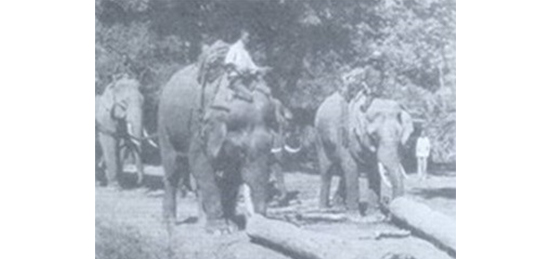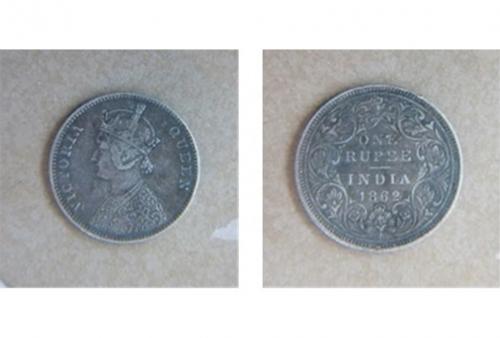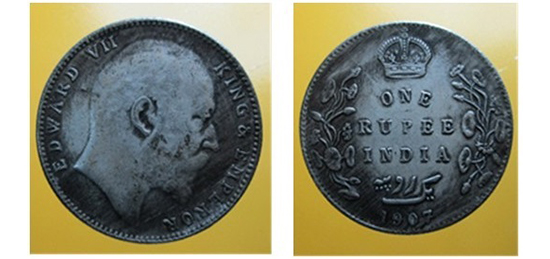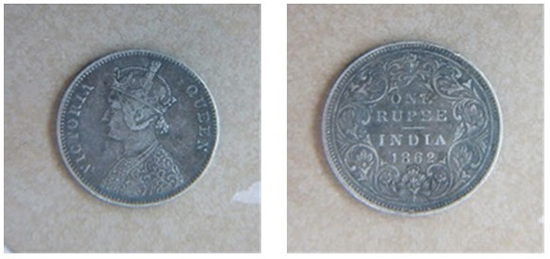Jarinya Boon-amornwit*
The use of the rupee, the unit of currency in India, began when British merchants bought and sold goods –
especially teak wood in Myanmar and the Lanna Kingdom. The money used in the Lanna Kingdom at that time was inconvenient for buying expensive products. This led to the rupee becoming the standard unit of currency in the Lanna Kingdom for a long time.
History of the Lanna Kingdom
The Lanna Kingdom was located in the northern part of Thailand and covered eight provinces which were Chiang Mai, Lamphun, Lampang, Chiang Rai, Phayao, Mae Hong Son, Phrae and Nan. King Mengrai was the first king. He occupied and united the Hariphunjaya Kingdom, the Yonok Kingdom and other cities to establish the Lanna Kingdom in 1296. community and culture. With a political policy of expanding the kingdom’s territories, King Mengrai sent his relatives to rule his colonies and new cities.
The Lanna Kingdom expanded widely during the reign of King Tilokaraj, the 9th monarch of the Mengrai dynasty. At that time, Lanna was bordered on the north by Jinghong and Yawng and in the east by Nantaburi (Nan), Prae to Luang Prabang. To the west was the Shan state (the northwest of Myanmar) which included Laihka, Hsipaw and Yawnghwe.
The Lanna Kingdom engaged in trade with many cities, therefore foreign merchants from Yunnan, Shan state, Myanmar, Luang Phabang and Vientiane entered the kingdom. Chin Haw merchants from Yunan and Shan merchants from the Shan state played the most important role in trading with Lanna. Lanna was once occupied by King Bayinnaung Kyawhtin Nawrahta, the king of Myanmar, from 1558 to 1774. When King Kawila became the ruler of Chiang Mai, he surrendered to the Thonburi Kingdom. Eventually Lanna was free from Myanmar and started to revive the kingdom.
The Relation between the Lanna Kingdom and Myanmar as a colony of Britain
After the First Anglo - Burmese War in 1826, the British occupied Mon where its boundary adjoined Lanna. When the war ended in 1828, Chao Bunma, the ruler of Lamphun invited the British governor-general staying in Mawlamyine to go to Lamphun. In 1829, Dr. Richardson and Myanmar merchants bought elephants, cows, and buffaloes in Chiang Mai, Lamphun and Lampang. They came to Lanna to trade many times. This was the initial period of trading between the British and Lanna.
The Teak Trade between Lanna and Myanmar as a colony of Britain
During the First Anglo – Burmese War, the British occupied important cities in Mon province. Due to the many large teak plantations in the area, the British established a sawmill in Mawlamyine in order to cut teak logs into lumber for sale abroad. As commercial forest plantations expanded, more British and Burmese traders entered Lanna to trade and establish forest concessions at the border between Myanmar and Lanna. In 1840, Mon people in Myanmar were allowed to set up forest concessions in Chiang Mai, Lamphun and Lampang as a document during the reign of King Rama III stated: "In 1842 Phraya Chakri wrote to Phra Chao Mahotara Prathet, the 5th ruler of Chiang Mai of the Thipchak dynasty, informing that Mon, Myanmar and British people bought wood at the northern border. They were allowed to cut down trees at the Khao Yai forest in Tak, Chiang Mai and Lamphun. They paid fees to some officials but they sometimes neglected to pay them, so they sued them. In order to solve the problem, the government ordered all cities to conduct the lumber trade without conflict.” In 1846, a contract concerning the price of teak logs was made between Chiang Mai and the British governor-genera in the Tanintharyi Region.
After the reign of Phra Chao Mahotara Prathet, the teak trade in Lanna expanded even more and problems and disputes about the forest concessions increased. In 1858, the British occupied all of India. The British rulers in India had the mint in Calcutta produce Indian rupee coins because of the coins standard size, weight and shape. The British used the Indian rupee in Lanna because there was not enough currency in Lanna. In addition, Myanmar merchants also used the rupee in Lanna. The rupee was called "Ngoen Tab” by the Lanna people. The following evidence shows the use of the rupee in the teak trade between Lanna and the British colony of Burma.
"According to the British governor-general’s announcement in 1861, Mawlamyine was a port for the teak trade. Ninety-five percent of the teak was from the border of Chiang Mai which the price of teak logs was fixed during the reign of Phra Chao Mahotara Prathet. There were three price categories considering from their sizes which were: (1) 8 -10 fist cost one rupee, (2) 11- 13 fist cost two rupees and (3) 14- 16 fist cost three rupees. After the Royal Forest Department was founded in 1896, the price of teak logs was fixed at 12 rupee each.”
In 1897, the price of teak logs was raised because of the higher price of teak in the Chao Phraya and Salween river basins. A large log from the Chao Phraya River basin cost 10 rupees while a small log cost 6 rupees. A large log from the Salween river basin cost 12 - 16 rupees while a small log cost 6 – 8 rupees. The total revenue from the teak trade was 200,000 rupees each year. The money was divided equally between the British government and the Lanna rulers. This was the reason why the Siam government later took control of the wood trade. The teak log trade had used the rupee from the beginning and although the Siam government founded the Royal Forest Department with its headquarters in Chiang Mai, people still used the rupee for business.

The elephants were dragging teaks' logs.
Designs of Rupee Coins Used in Lanna
According to the Royal Institute Dictionary (1999), the rupee is the unit of money used in India. However, rupee and rupia both appear in Thai documents and are pronounced similar to Hindi language. The terms were used in documents during the reign of King Rama IV and King Rama V. In the past, the people of Lanna called the rupee "Ngoen Tab” and "Rupia”. Presently, they still use both words.
There were two designs of rupee in Lanna which were:
1. Silver coin, one rupee denomination Obverse:
The portrait of Queen Victoria wearing a crown is at the center. The inscription "VICTORIA”
is on the left border and "QUEEN” is on the right border.
Reverse: Lilies runs along the border. The inscription "ONE RUPEE INDIA 1862” is at the center.
Lanna people called this coin: "Ngoen Kra Joom”.
Silver coin, one rupee denomination
The portrait of Queen Victoria is at the center.
2. Silver coin, one rupee denomination
Obverse: The portrait of King Edward VII is at the center. The inscription "EDWARD VII” is on the left border and "KING & EMPEROR” is on the right border.
Reverse: The crown is above the inscription "ONE RUPEE INDIA”. The Indian inscription and "1907 A.D.” are below, flanked by water lilies.
King Edward VII rupee coins contained more pure silver than the Queen Victoria coins. Lanna people called the coins "Ngoen Hao Mod” (Ngoen means money, Hao means head and Mod means away.) because of Edward VII’s bald head portrait.
Silver coin, one rupee denomination
The portrait of King Edward VII is at the center.
The Change of Currency: from the Rupee of India to the Baht of Siam
The rupee was widely used for the teak trade in Lanna. Eventually, the Siam government attempted to
depreciate the importance of the rupee. During the reign of King Rama V in 1898, the Siam government began circulating the Thai baht currency in the Lanna economy, but this was not successful. The causes came from two problems. There was not enough currency in Siam and the currency was very heavy in weight, which was inconvenient for transportation. In 1916, a new rail line was expanded from Siam to Lamphang, and later to Chiang Mai, making the trade between Siam and Chiang Mai more active. During the reign of King Rama VI in 1921, land transportation became more important. In addition, the route for teak transportation via the Salween River in Myanmar changed to the Chao Phraya River in Siam. This caused trade between Lanna and Mawlamyine to become less
important. Goods from Siam, Germany and Japan were cheaper than goods from England. As a result, the rupee depreciated in value and the baht currency became more circulated and popular in Lanna. After Siam changed its government to a democracy in 1932, the city of Payap Monthon was abolished while other cities in Lanna were developed into provinces and districts. During World War II, from 1941 – 1945, the British Borneo Company and the Bombay Burma Trading Company abandoned the logging business in Thailand leading to the Indian rupee on longer being circulated in Lanna. In 1947,two years after the end of World War II, India attained independence from the British. The British Raj withdrew from India and production of the rupee by the British ended.
*Curaotor, Professional Level at Bureau of Grand National Treasure under the Treasury Department



